Kyoto in June: The Best 10 Hydrangea Spots in 2025

The best time to see hydrangeas in Kyoto is June, during the rainy season. Mimurotoji Temple and Yanagidani Kannon are just two of Kyoto's famous hydrangea spots. We introduce 10 beautiful hydrangea spots in Kyoto, from photogenic locations to little-known finds.
Hydrangea Viewing in Kyoto
Hydrangeas bloom during the rainy season in Japan. Their large blooms with enchanting hues of blue, purple, pink, and white capture everyone's hearts.
In Kyoto, there are several places with beautiful hydrangeas, from famous locations that always attract crowds to little-known spots. Read on to learn about 10 hydrangea locations within Kyoto City and its surroundings.
Hydrangea Spots in Kyoto
Within Kyoto City and the Suburbs
1. Mimurotoji Temple
2. Yokokuji Temple
3. Yoshiminedera Temple
4. Sanzen'in Temple
5. Fujinomori Shrine
6. Chishakuin Temple
7. Kenninji Temple - Reigenin Temple
Famous Places Further Out from Kyoto City
8. Gansenji Temple in Kizugawa
9. Tanshu Kannonji Temple in Fukuchiyama
10. Maizuru Nature and Cultural Park
Get 3,000 Yen Off! Take stunning hydrangea photos with Capture My Japan!
Read also
Within Kyoto City and the Suburbs
First, we’ll introduce spots easily accessible within Kyoto and it suburbs.
1. Mimurotoji Temple
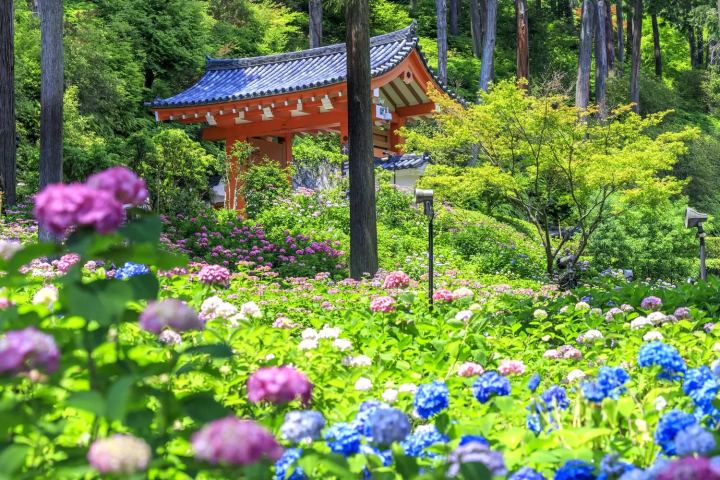
Photo by Pixta
Mimurotoji Temple, also known as Hydrangea Temple, is located at the base of Mt. Myojo, a mountain range north of the Uji River.
The Amitabha Triad, created during the Heian period (794-1185), is a nationally designated important cultural property. The temple architecture includes the Main Hall, which was either constructed or re-constructed during the Edo period (1603-1868), the Amida Buddha Hall, three-storied pagoda, and Juhachi Shrine Main Hall constructed in the Muromachi period (1333-1572).
The temple has many charms, including a well-maintained chisen kaiyu-style garden, which features a circular promenade around a pond. A rock garden and various stone monuments are also interspersed around the temple.
In June, as many as 20,000 hydrangeas in 50 varieties decorate the temple grounds. These varieties include hydrangea macrophylla, lacecap hydrangea, and an elusive variety of hydrangea serrata.
The temple is 15 minutes away on foot from Keihan Mimurodo Station. However, during the hydrangea season, it can be extremely crowded. Therefore, we recommend visiting by public transportation rather than by vehicle.
Mimurotoji Temple
Address: Kyoto, Uji, Todo Shigatani 21
Peak Season: Early June to early July (*the hydrangea garden opens from June 1 - July 7, 2024)
Official Website: https://www.mimurotoji.com/ (Japanese)
2. Yanagidani Kannon (Yokokuji Temple)
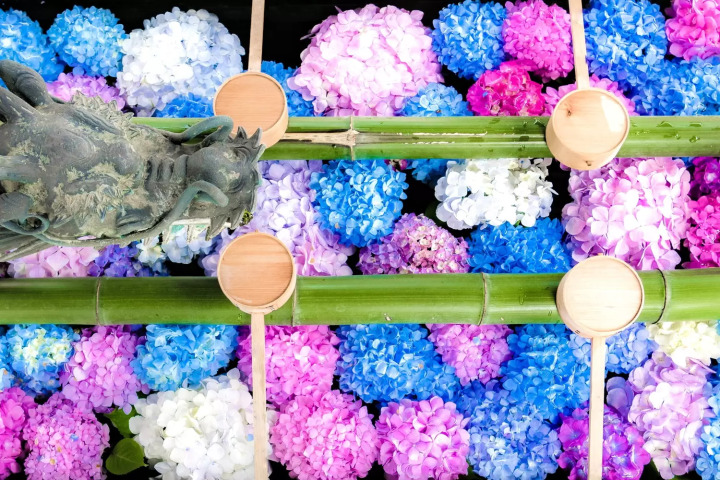
Photo by Pixta
Yanagidani Kannon Yokokuji Temple is an ancient temple that was said to have been established at the outset of the ninth century. The Main Hall was constructed during the Edo period and enshrines the eleven-faced, thousand-armed statue of Kannon. This statue is believed to heal various diseases, including eye diseases.
The Jodo Garden, which sits between the Main Hall and Study, is a prefectural designated place of scenic beauty. The garden can be appreciated from the study.
Okozui, spring water believed to have been turned into sacred water by the monk Kobo Daishi to help those suffering from eye diseases, draws worshipers as sacred water that heals diseases of the eye.
A total of 5,000 hydrangeas go into full bloom on the temple grounds come June, and this is where the Yanagidani Kannon Hydrangea Week is held. During the festivities, you can take a stroll while enjoying the various varieties of hydrangeas.
There’s also hanachozu, hand purification basins decorated with floating hydrangeas, a special viewing of the Kamishoin Study, getting limited-time temple stamps, and other workshops to enjoy.
The temple is 10 minutes by taxi from Hankyu Nishiyama-Tennozan Station. A shuttle bus is available for transportation between the station and the temple on the 17th, the holy day of every month.
Yokokuji Temple
Address: Kyoto, Nagaokakyo, Jododani Donotani 2
Peak Season: Early June to early July
Official Website: https://yanagidani.jp/ (Japanese)
3. Yoshiminedera Temple
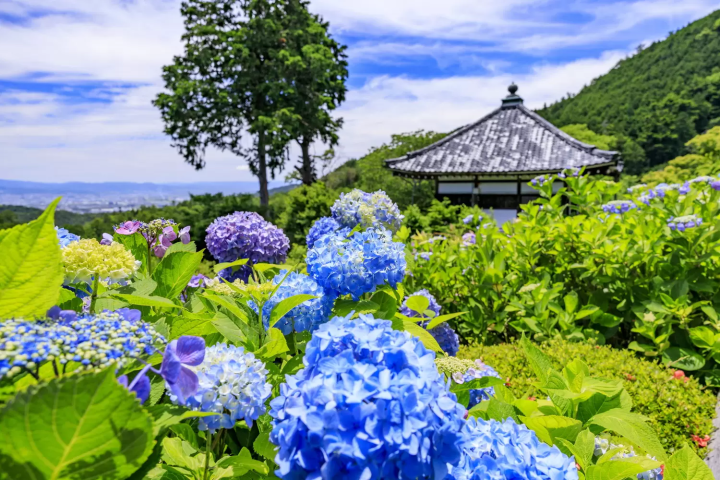
Photo by Pixta
Yoshiminedera Temple was founded in Kyoto Nishiyama at the beginning of the 10th century.
The principal object is Amitabha, represented here by a statue with a jeweled crown, and the current temple was constructed in the 17th century. The temple grounds are interspersed with valuable architecture and Buddhist statues, many of which have been designated important cultural properties in various places. The temple also has a 9.9-hectare promenade garden, so you can enjoy the plants and seasonal flowers while touring the temple.
It will take about 40 minutes to complete an entire lap around the temple, but there are viewing spots throughout the temple that provide a panoramic view of the streets of Kyoto. Therefore, we recommend visiting with enough time to hike at a relaxed pace.
During the early summer, 8,000 hydrangeas bloom throughout the temple, including varieties such as hydrangea macrophylla, lacecap hydrangeas, and mountain hydrangeas. The other seasons are equally beautiful, with plum blossoms, cherry blossoms, and azaleas in the spring or chrysanthemums and autumn leaves in the fall.
You can get to the temple in 30 minutes by bus from JR Mukomachi Station or Hankyu Higashimuko Station.
Yoshiminedera Temple
Address: Kyoto, Kyoto, Nishikyo, Oharano Oshiocho 1372
Peak Season: Mid-June to early July
Official Website: http://www.yoshiminedera.com/index.html (Japanese)
4. Sanzen'in Temple
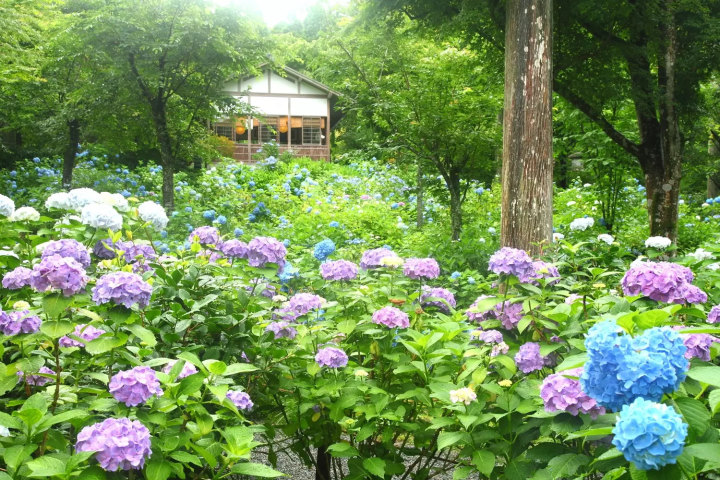
Photo by Pixta
Sanzen'in Temple is an ancient temple dating from the late eighth to early ninth century. The temple was later moved several times until it moved to present-day Ohara after the Meiji Restoration (1868).
The principal object is Bhaisajyaguru, which is said to be the work of the monk Dengyo Daishi but later became a statue withheld from public view. The Amitabha Triad statue, a national treasure, is enshrined in the Ojogokurakuin Hall, located at the center of the temple grounds.
Walk through the Gotenmon Gate, surrounded by tall stone walls, and you’ll find two gardens. Shuheki Garden is a garden centered around a pond located near the Guest Hall. At the same time, Yusei Garden is a garden with a circular promenade around a pond next to the Main House. You can appreciate the seasonal scenery through these two gardens.
Thousands of hydrangeas planted in front of the Konjiki Fudodo Hall go into full bloom around mid-June, starting from the nettle-leaved hydrangea, followed by the rare star hydrangea, mountain hydrangea, and lacecap hydrangeas. You can enjoy these colorful flowers during this time.
It is accessible in an hour by bus from Kyoto Station or 30 minutes by bus and on foot from Kokusaikaikan Station.
Sanzen'in Temple
Address: Kyoto, Sakyo, Ohara Raikoincho 540
Peak Season: Early June to mid-July *The Hydrangea Festival is scheduled to be held from June 9 to July 7, 2024.
Official Website: http://www.sanzenin.or.jp/en/
5. Fujinomori Shrine
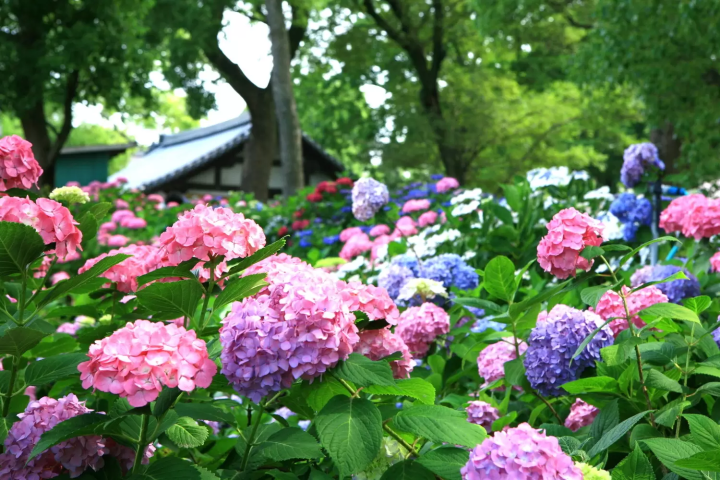
Photo by Pixta
Fujinomori Shrine is an ancient shrine constructed before the Heian period. The Fujinomori Festival—held annually on May 5th—is believed to be the festival from which Boys’ Day, now a celebration for all children, originated.
The shrine is worshiped as the god of victory because sweet flag (“shobu” in Japanese), an herb strongly associated with Children’s Day, sounds like victory (also “shobu” in Japanese). Due to the horse rituals performed during the Fujinomori Festival, the shrine is also worshiped by racehorse owners, jockeys, and horse racing fans as the god of horses.
During the early summer, nearly 3,500 hydrangeas in various colors decorate the shrine grounds in early summer. The Hydrangea Festival is held for one month in June. You can enjoy various festivities during the event, including Shinto rituals, gagaku (traditional Japanese court music), bugaku (traditional court dance), and taiko drum performances.
The shrine is accessible in five minutes on foot from JR Fujinomori Station.
Fujinomori Shrine
Address: Kyoto, Fushimi, Fukakusa Toriizakicho 609
Peak Season: Early June to mid-July (The Hydrangea Festival is scheduled to be held June 1-30, 2024)
Official Website: http://www.fujinomorijinjya.or.jp/ (Japanese)
6. Chishakuin Temple
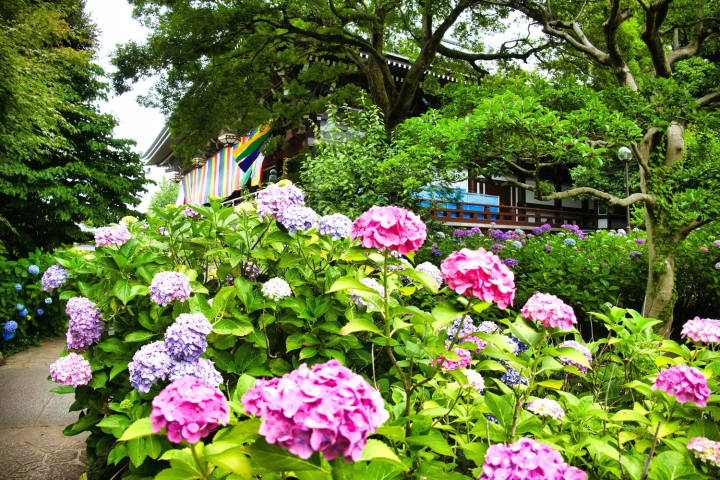
Photo by Pixta
Chishakuin Temple is the head temple of the Chisan School of Shingon Buddhism, which has 3,000 temples across Japan. Kondo, or the main hall, is where the statue of Dainichi Buddha is enshrined.
The garden can be viewed from the Ojoin Reception Hall and appears much the same as during the Edo period. It is a nationally designated place of scenic beauty.
An artificial mountain sits in the background and supplies the long, narrow pond with water from the mountain’s waterfall. Satsuki azaleas show their brilliant colors in the spring, but you can also enjoy autumn leaves in the fall and hydrangea flowers in the early summer.
Chishakuin Temple is accessible in 10 minutes on foot from Keihan Shichijo Station or a little less than 15 minutes by bus and on foot from Kyoto Station. It’s on the smaller side compared to other hydrangea spots but remains a little-known find with great access in central Kyoto.
Chishakuin Temple
Address: Kyoto, Kyoto, Higashiyama, Higashikawaracho 964
Peak Season: Early June to early July
Official Website: https://chisan.or.jp/en
7. Kenninji Temple - Reigenin Temple
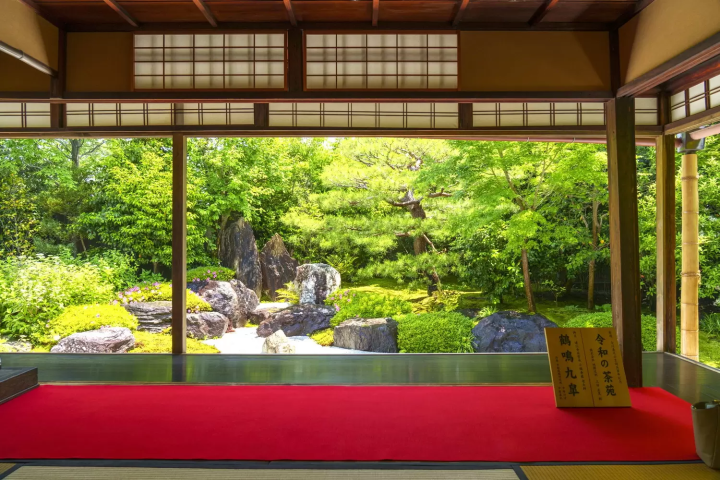
Photo by Pixta
Kenninji Temple, the head temple of the Rinzai Kenninji school, was the first Zen temple in Kyoto constructed in the early 13th century.
Kenninji has several sub-temples within the same grounds. Reigenin Temple is one of them. You can view the seated figure of Chugan Engetsu—a nationally designated important cultural property—and the standing Bishamonten—normally withheld from public view—from within that statue.
You can also see the Japanese rock garden from the Main Hall, which represents the entire life cycle of Buddha from birth to entering nirvana.
During early summer, you can admire a hydrangea variety in the same family as the lacecap hydrangea called amacha that blooms in the garden. Amacha is a beautiful blue flower processed into tea leaves once steamed, rolled, and dried.
Reigenin Temple’s garden, where you can find this amacha variety, has been completely revitalized in recent years through new landscaping and design. It has received a lot of attention and interest from others.
Kenninji Temple - Reigenin Temple
Address: Kyoto, Higashiyama, Yamato-oji Shijo-sagaru Komatsucho 594 Reigenin
Peak Season: Around late May to early June
Official Website: https://www.reigenin.jp/ (Japanese)
Famous Places Further Out from Kyoto City
There are also many famous and well-known hydrangea spots outside of Kyoto City. In this next section, we'll introduce Gansen-ji Temple, located near Nara Prefecture, and two famous spots in the northern part of the prefecture.
8. Gansenji Temple in Kizugawa

Photo by Pixta
Gansenji Temple is an ancient temple believed to have been constructed in the early eighth century. It is home to numerous nationally designated important cultural properties, including its three-storied pagoda. The three-storied pagoda stands tall amongst the trees and is a sight that evokes the majesty of a mountain temple.
Amitabha, the principal object of worship, is a three-meter-tall standing statue. It is a valuable statue created in the mid-tenth century, with some of its original coloring remaining. Along with the statue of Samantabhadra riding an elephant, which is enshrined near the principal object, it is designated an important cultural property.
The temple grounds are surrounded by nature and refreshing air, making it famous as a flower temple due to various seasonal blooms. Enjoy cherry blossoms, plum blossoms, azaleas, and lily magnolia in spring, or Japanese irises, water lilies, Chinese bellflowers, and crape myrtle in early summer. Come autumn, the autumn leaves, coralberry, camellia sasanqua, and wintersweet will be in season.
Hydrangeas in early summer are especially popular. This is an incredibly unique and rare spot since you can take photos of the three-storied pagoda, a cultural property, and hydrangeas in a single frame.
The temple is accessible in 15 minutes by community bus from JR Kamo Station.
Gansenji Temple
Address: Kyoto, Kizugawa, Kamocho, Iwafune Kaminomon 43
Peak Season: Early June to early July
Official Website: https://gansenji.or.jp/ (Japanese)
9. Tanshu Kannonji Temple in Fukuchiyama
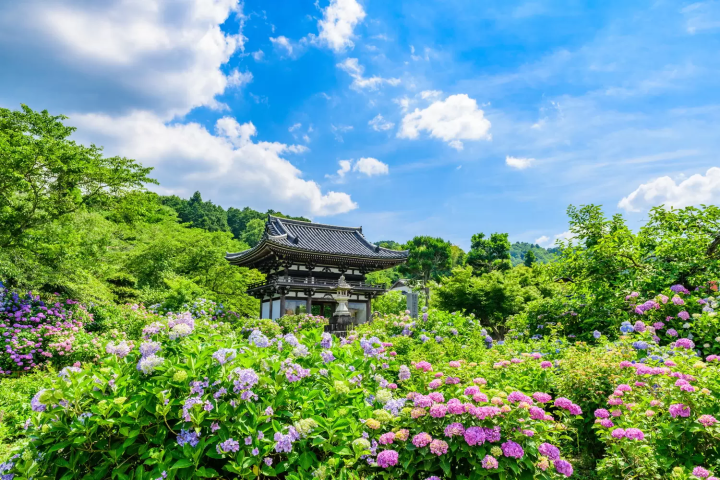
Photo by Pixta
Tanshu Kannonji Temple was established in the eighth century. The temple houses the eleven-faced, thousand-armed statue of Kannon, the principal object of worship normally withheld from public view. However, several other statues, like the standing wooden statue of Fudo Myoo, are designated cultural properties.
There is a legend at Tanshu Kannonji Temple that states the Kannon cured people of their eye diseases with spiritual power. As a token of gratitude, the cured people planted numerous hydrangea bushes around the temple. This is why it's also nicknamed the Hydrangea Temple.
A total of 10,000 hydrangeas in 100 varieties go into full bloom between June and July every year. During this time, you can see a gorgeous landscape reminiscent of a “Flowery Pure Land.”
Access is 15 minutes on foot from Isa Station on the JR San-in Main Line.
Tanshu Kannonji Temple
Address: Kyoto, Fukuchiyama, Kannonji 1067
Peak Season: Mid-June to early July
Official Website: https://www.tanba-ajisaidera.com/ (Japanese)
10. Maizuru Nature and Cultural Park
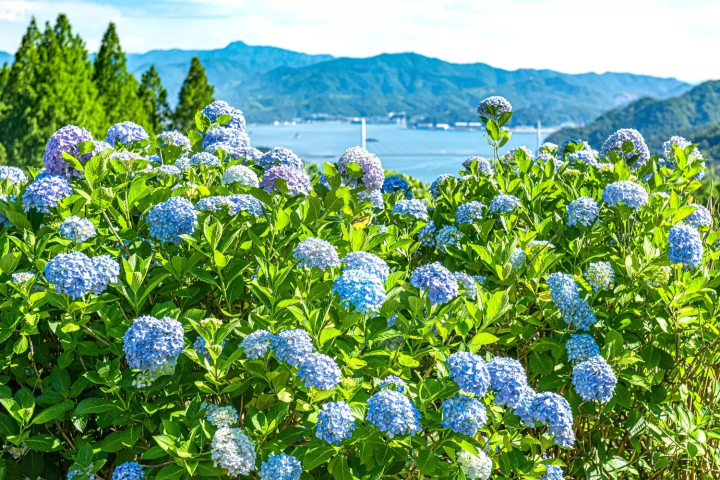
Photo by Pixta
This nature-rich city park is located on the Oura Peninsula in Maizuru, 30 minutes by bus from JR Higashi-Maizuru Station. The park is 34.7 hectares in size and decorated with flowers every season, making it an excellent spot to watch nature. The scale of hydrangeas is one of the largest in Japan.
The hydrangea garden contains about 10,000 hydrangeas, creating an incredible landscape that extends like the ocean.
The park is also known for its camellia garden, which houses 30,000 camellias in 1,500 varieties. The autumn leaves, and scenery are also gorgeous in the fall. The park is only open to the public during the camellia (around March), hydrangea (between June and July), and autumn leaves (around November) seasons.
Maizuru Nature and Cultural Park
Address: Kyoto, Maizuru, Taneji 24-12
Peak Season: Mid-June to early July (the park was open from July 15-July 2, 2023)
Official Website: https://www.city.maizuru.kyoto.jp/kurashi/0000008943.html (Japanese)
Read also
With the Rainy Season Comes Hydrangea Parfaits!
Kyoto is home to many hydrangea spots. During the rainy season, you can enjoy a special hydrangea parfait at various cafes!
The parfait at Itoh Kyuemon Uji Main Store, a cafe near Mimuroto-ji Temple, is extremely popular.
Fully experience hydrangeas not only with your eyes but also with your taste buds!
Read also
Main image by Pixta













































![[2026] Top 5 Strawberry Picking Spots in Tokushima, Naruto| Farms and Access Guide for January to May](https://resources.matcha-jp.com/resize/720x2000/2025/03/06-227165.webp)
![[Yamanashi/ Hokuto City] 4 Hot New Spots Opening in 2026](https://resources.matcha-jp.com/resize/720x2000/2025/12/12-252747.webp)


